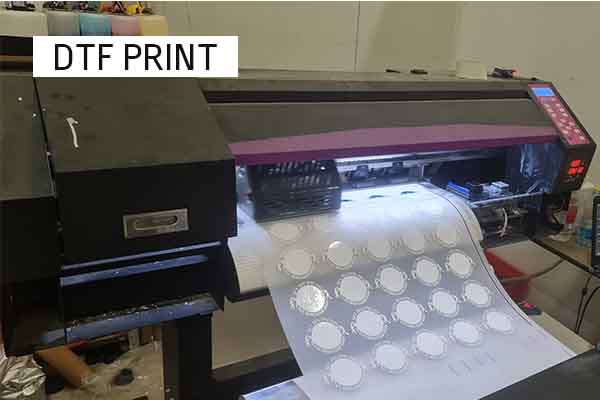Ultimate Overview to DTF Printing Methods for Spectacular Fabric Layouts
Beginning on the journey of mastering DTF printing techniques can open up a globe of opportunities for producing visually captivating fabric layouts. In this guide, we will explore the detailed information of DTF printing, from understanding the fundamental basics to unraveling progressed color methods that can elevate your styles to new heights.
Comprehending DTF Printing Fundamentals
DTF printing, a process that entails moving designs from an unique movie to textiles making use of warm and pressure, creates the foundation of textile printing strategies. This ingenious method permits for top notch, lively designs to be flawlessly transferred onto various textiles with precision and information. The very first step in DTF printing includes creating or choosing a design that will certainly be printed onto the textile. This layout is after that published onto a special movie utilizing a DTF printer, which uses certain dyes or pigments to ensure shade precision and sturdiness.
The last outcome is a magnificent, long-lasting textile design that is washable, flexible, and resistant to fading. In general, comprehending the fundamentals of DTF printing is vital for grasping this contemporary textile printing technique.
Choosing the Right Textile Materials
Having actually developed the fundamental concepts of DTF printing methods for textile designs, the next critical consideration hinges on picking the ideal fabric products to match this innovative procedure efficiently. The success of a DTF print greatly depends on the compatibility between the picked material and the printing technique. When choosing fabric materials for DTF printing, it is necessary to consider the fabric's make-up, weave, and appearance. Fabrics that work well with DTF printing include polyester blends, spandex, nylon, and various other artificial materials. These fabrics commonly have a smooth surface area that permits thorough and vivid prints. In addition, the stretchability of these materials can suit the warm transfer process involved in DTF printing without misshaping the design. It is suggested to avoid all-natural fibers such as cotton or silk, as they may not yield the very same level of print quality and toughness. By selecting the appropriate textile products, designers can optimize the potential of DTF printing to develop spectacular and long-lasting fabric designs.

Grasping the Printing Refine
To master DTF printing techniques for textile styles, understanding the printing procedure is important for accomplishing regular and high-quality results. The printing process in DTF includes a number of vital actions that call for accuracy and focus to information. Firstly, preparing the art work for printing is crucial. This includes guaranteeing the design is correctly sized and positioned for the fabric. Next off, the layout is published onto an unique DTF film utilizing a compatible printer with the best settings to achieve optimal shade vibrancy and quality (DTF Printing). As soon as check my source the style is published, it is then transferred onto the fabric using a warmth press equipment. The temperature level, pressure, and duration of heat application have to be meticulously regulated to make certain appropriate bond of the design to the textile. In addition, understanding the peeling process after warmth pushing is important to avoid any damages to the style or fabric. By sharpening each of these action in the printing process, see it here designers can continually create sturdy and sensational textile layouts with DTF printing methods.
Enhancing Layouts With Color Methods

Additionally, try out shade slopes can bring a sense of motion and fluidity to the style. By blending colors perfectly, a gradient effect can be achieved, adding a modern and vibrant touch to the fabric style. Furthermore, using color blocking check over here techniques can create bold and striking visuals by comparing various solid colors in distinct areas of the layout.
Additionally, integrating metallic or neon shades can give a distinct and appealing component to the textile layout, making it stick out and emanate a sense of vibrancy. When purposefully used, these color methods can elevate the total aesthetic allure of textile layouts, making them a lot more unforgettable and exciting.
Troubleshooting Common DTF Printing Issues
After discovering numerous shade strategies to boost fabric layouts, it is essential to address common DTF printing problems that might emerge throughout the production process. Furthermore, concerns with photo quality and intensity can happen due to low-resolution pictures or incorrect printing methods. By being mindful of these usual troubles and implementing the necessary troubleshooting steps, you can improve the total top quality of your DTF published fabric layouts.
Final Thought
In verdict, grasping DTF printing strategies is vital for creating sensational textile styles. With technique and interest to information, one can create special and gorgeous fabric designs utilizing DTF printing strategies.
)))))
DTF printing, a procedure that entails transferring styles from a special movie to fabrics using warm and stress, forms the foundation of fabric printing strategies.Having established the fundamental concepts of DTF printing techniques for textile styles, the following critical consideration exists in picking the suitable textile products to enhance this innovative process successfully. By picking the best textile products, designers can take full advantage of the potential of DTF printing to produce magnificent and lasting textile styles.
To succeed in DTF printing techniques for fabric layouts, grasping the printing procedure is crucial for accomplishing top quality and regular results. DTF Printing. By refining each of these steps in the printing process, designers can continually produce sensational and sturdy fabric layouts with DTF printing methods